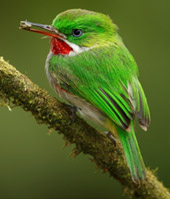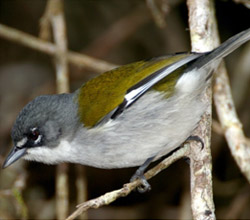Conservation Genetics
The Caribbean island of Hispaniola is unusual in that it supports many endemic sister species of birds, suggesting that many within-island radiations have occurred. Some of the endemic, congeneric species pairs on Hispaniola include the Eastern and Western Chat-Tanagers, the Gray-headed and Black-headed Palm-Tanagers, the White-winged Warbler and Green-tailed Ground-Warbler, and the Broad- and Narrow-billed Tody. Current theory and empirical evidence suggest that within-island speciation in birds is unlikely in all but the largest islands, and so this amazing diversification of endemic birds on Hispaniola begs explanation. In addition, some populations that are unique to Haiti are of desperate conservation concern.


One of the congeneric species pairs on Hispaniola, the Broad-billed Tody & Narrow-billed Tody. Photos courtesy of Eladio Fernandez.
We have been working on a comparative phylogeography and conservation genetic study of Hispaniolan endemic birds. To date, our work has shown ancient divergence between the two species of Chat-Tanagers that coincides with the previous configuration of Hispaniola as a North and South proto-island (Townsend et al. (2007) Mol. Ecol.).

Another congeneric species pair onHispaniola, the Green-tailed Ground Warbler & White-winged Warbler. Photos courtesy of Eladio Fernandez.
Work led by Nick Sly on the Palm-Tanagers (Sly et al. (2010) Cons. Genetics), the White-winged Warbler and Green-tailed Ground-Warbler, the Todies, and several endemic sub-species has illuminated differences in the probable sources and timing of divergence among these taxa (Sly et al (2011) Mol. Ecol.).
We are also interested in the biotic factors—both past and present—that have shaped and will alter current bird distributions. To this end, we are completing a comparative study of the breeding biology of Hispaniola’s Broad- and Narrow-billed Todies, and assessing evidence for competitive exclusion and character displacement between the two species.
Prior to our 2004-2005 expeditions, no genetic samples of birds had ever been collected in Haiti (Rimmer et al. (2005) Orn. Neotrop.). Field work in Haiti (described here in Birdscope), is logistically difficult in this politically unstable country. Our work represents an important contribution to conservation efforts in the critically endangered Haitian forest habitat.

